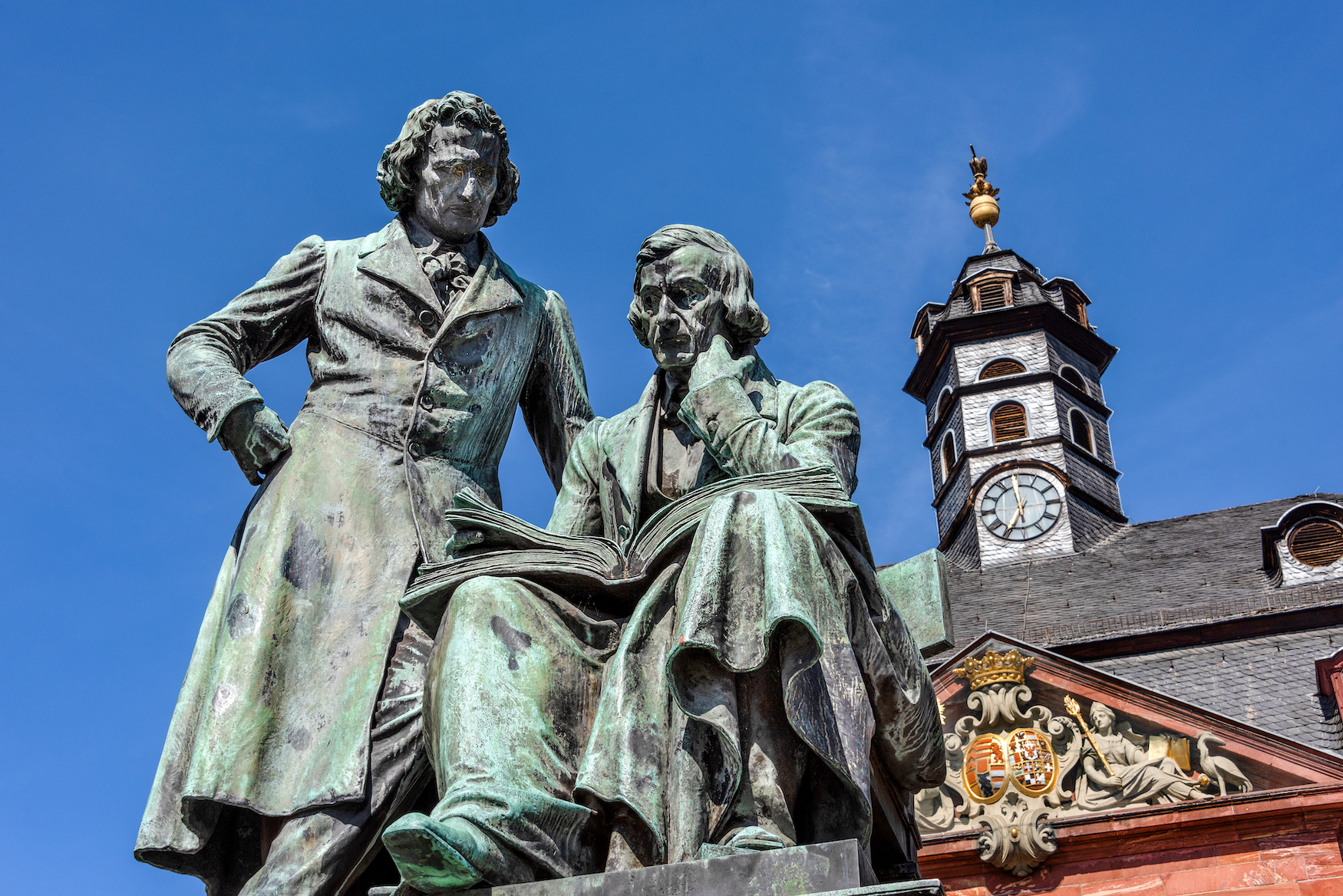Almost every child still knows their fairy tales today. They have been translated into some 160 languages, in such large circulations that only the Bible surpasses them. Jacob and Wilhelm Grimm spent their early years in Hanau where the small Hessian town shaped the spirit for their entire lives. Here is a city walk in the footsteps of the world-famous linguists and collectors of fairy tales!
There is the Brothers Grimm Street, the Brothers Grimm School and even the traffic light at the Freedom Square in Hanau, which magically surprises pedestrians when they are allowed to cross the street: as a traffic light man in the form of the brothers Wilhelm and Jacob Grimm, Germany’s most famous storytellers. We are in Hanau and Hanau is the Brothers Grimm city. The brothers belong to the Hessian town like the typical green sauce belongs to Frankfurt, 20 kilometers away. And so, it is not surprising that visitors see the name Grimm in many places throughout the city. And, of course, their fairy tales.
Jacob Grimm stands larger than life next to his seated brother, Wilhelm. Or, is it the other way around? According to legend, the brothers switch places at midnight. Since 1896, a bronze statue of them has sat in the town’s market square.
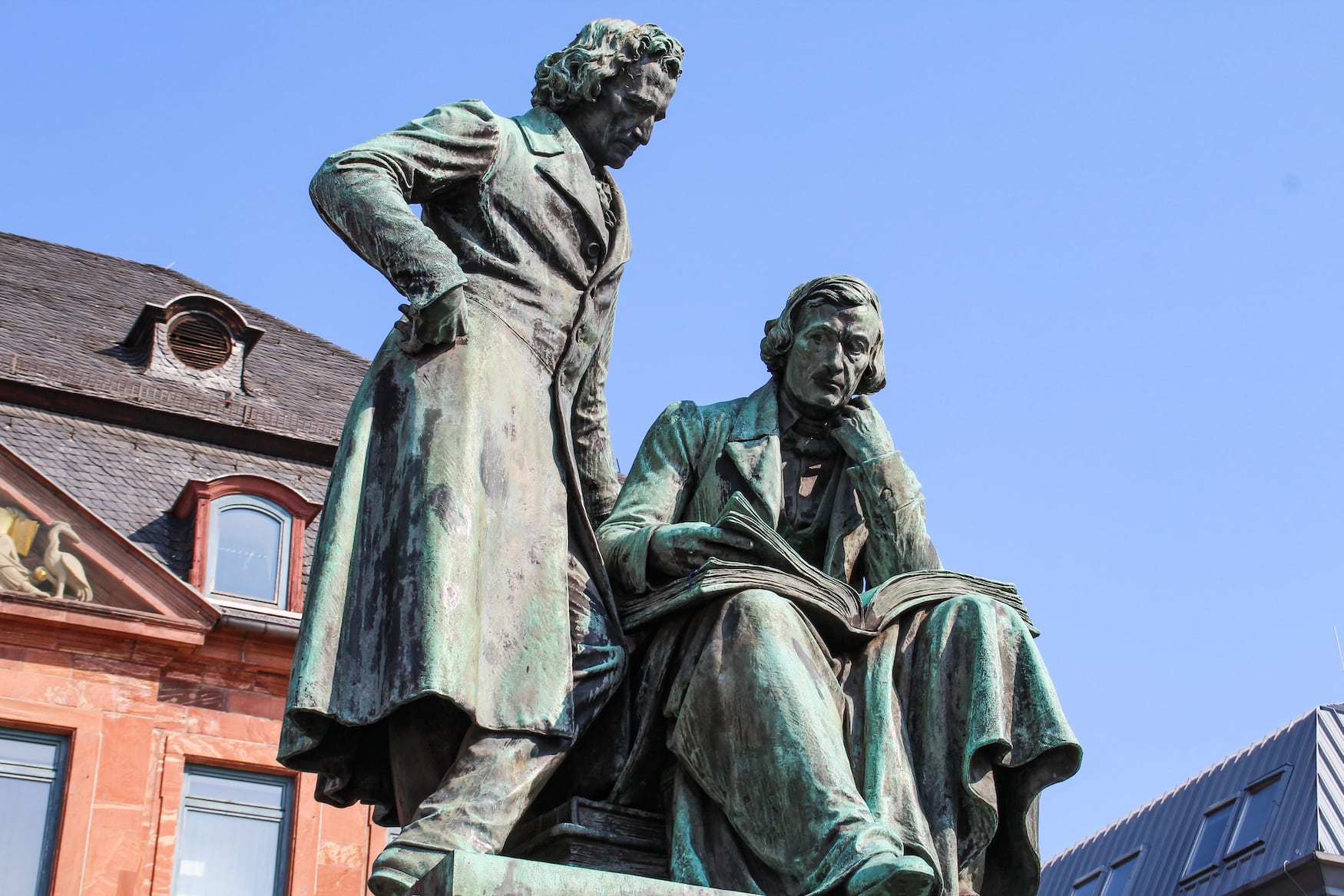
Fairy Tale Path
Together with ten other stations, they form the two-kilometer-long “fairy tale path” through Hanau: “King Drosselbart” welcomes visitors as a bronze sculpture on the Schlossplatz. In the old and new town, you will pass “Little Red Riding Hood”, “Puss in Boots”, the “Devil with the three big hairs” and “Tischlein deck dich”. You then need a little more time for the Freiheitsplatz, because there is a lot to discover here. On the one hand, the said traffic light man, on the other hand, the fairy tale sculptures, “Hop O’my Thumb’s Wanderings” and “Brother and Sister”.
The house where the brothers were born once stood on Freedom Square. Jacob was first born in 1785 and Wilhelm a year later. Three brothers and a daughter were to follow in the next few years. Unfortunately, the birth house, like most of the city’s buildings, was destroyed in World War II and replaced by a building which holds no real meaning.
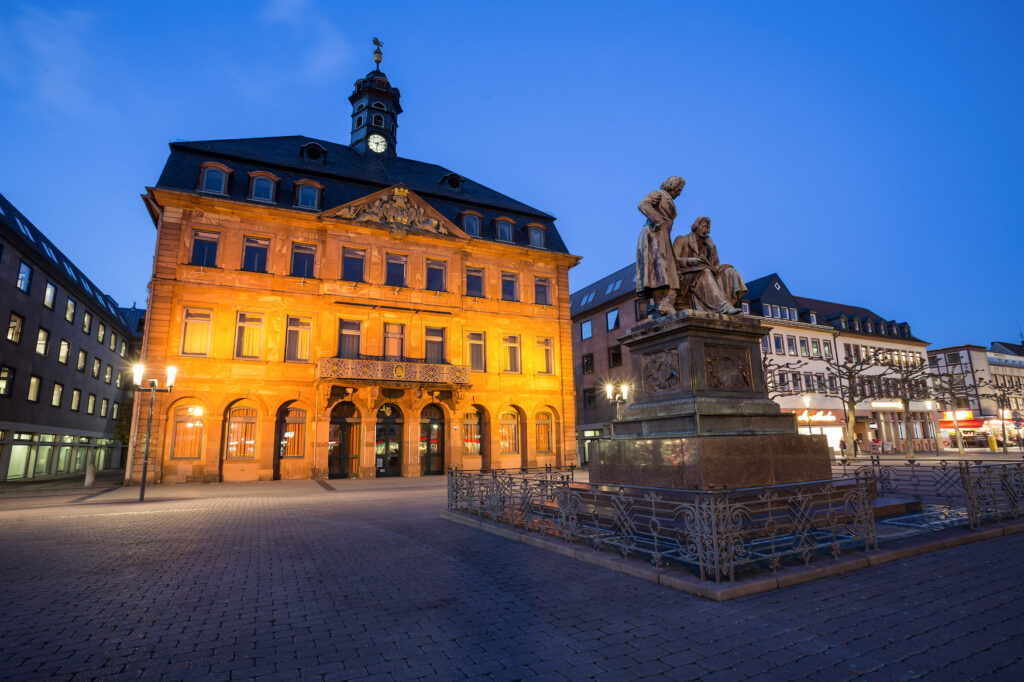
Take the Fairytale Train to Philippsruhe
It then continues like a fairytale – with the fairytale train, which takes visitors to Philippsruhe Castle, where the first German hands-on museum for the Brothers Grimm has been since 2019. “Grimm’s Fairy Tales” is great fun, especially for children. They can dress up as Sleeping Beauty or Little Red Riding Hood, climb Rapunzel’s Tower and make up their own fairy tale. In general, Philippsruhe is a nice destination. The beautiful baroque-style country palace on the banks of the Main with a historical museum is surrounded by a spacious park with an orangery, a sculpture park and a covered amphitheater. Every year from May to July, around 80,000 visitors are drawn to the Grimm Festival, which celebrates the famous sons and the imaginative richness of the Grimm’s fairy tales in the amphitheater.
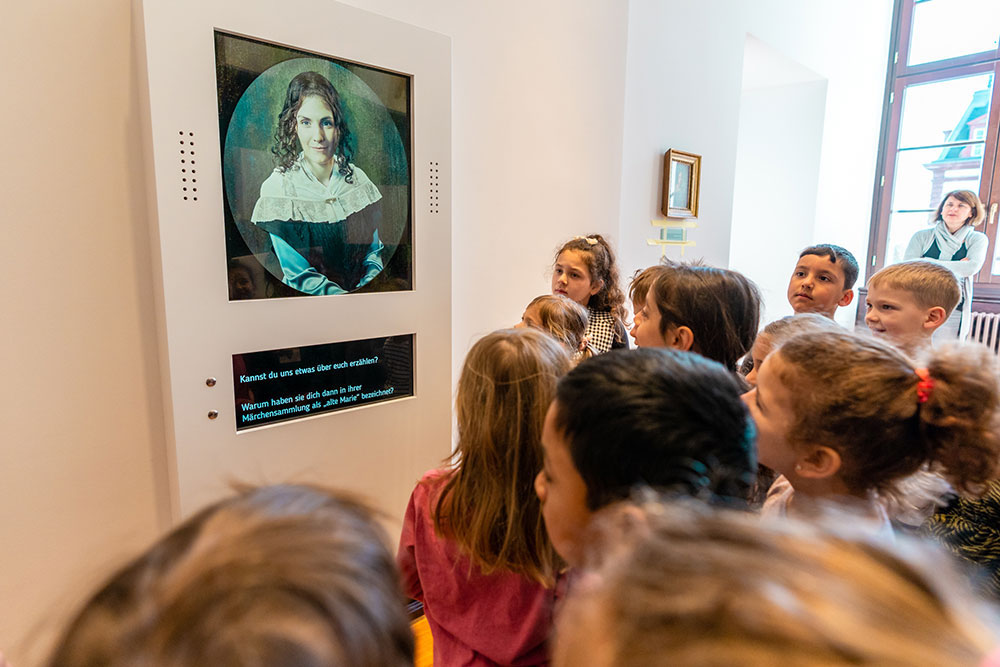
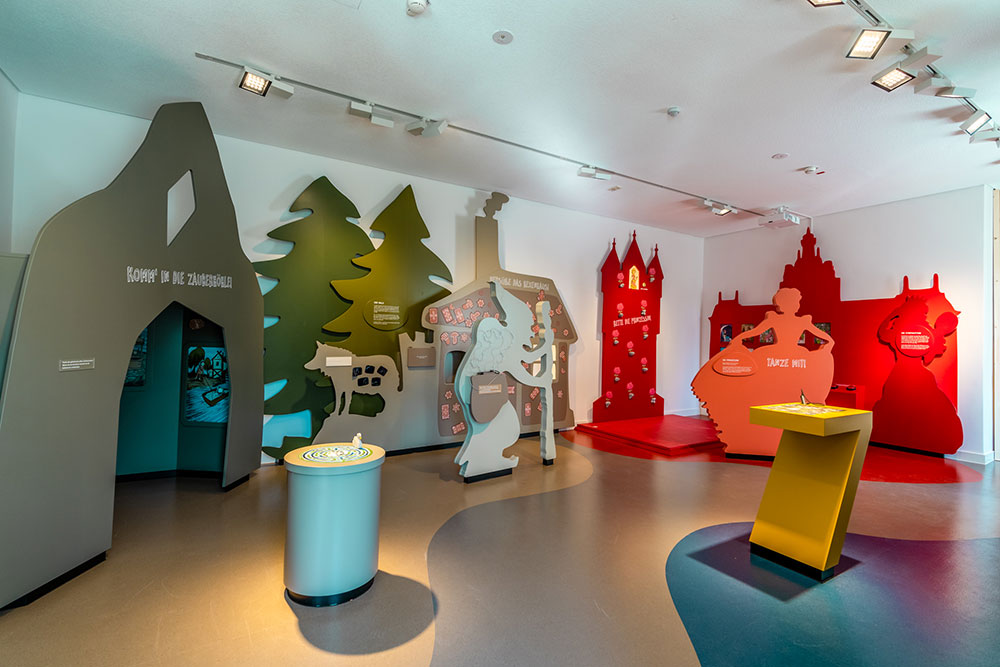
But how did the Grimms’ fairy tales come about? And why did the spirit of Hanau shape the brothers’ worldview so much?
At the end of the 18th century, Hanau was a busy city, known for its wool and silk fabrics, which were in high demand throughout Europe. In addition, Landgrave Wilhelm IX ruled the Hessen-Kassel region, a man of action who loved the muses and promoted education. So, he had a high school, a theater and a Latin school built in Hanau. And, there was even a newspaper that came out four times a week. Thus, Jacob and Wilhelm grew up with a free and enlightened spirit, which would then accompany them throughout their entire lives. Even when the family moved to Steinau, 50 kilometers away, in 1791, where their father took up a new position as a magistrate, the brothers continued their journey together: they attended high school together in Kassel, studied together in Marburg, worked as librarians and later as professors. As a member of parliament, Jacob even took part in the meeting of the first all-German parliament in Frankfurt’s Paulskirche in 1848.
In addition to the world’s most famous storytellers, they are above all Germany’s best-known linguists and folklorists. Jacob and Wilhelm Grimm wanted to (in all thoroughness) record the origin and use of every German word, even the entire New High German language from Luther to Goethe. The ambitious project of the “German dictionary” should have been completed within ten years and only cover a few volumes. In the end, it became a work of the century in the truest sense of the word. When the last volume appeared in 1961, both had been dead for a hundred years. Today, the Grimm Dictionary comprises a whopping 16 volumes. It is a monumental work of the German language and highly unique. It’s even in the Guinness Book of Records.
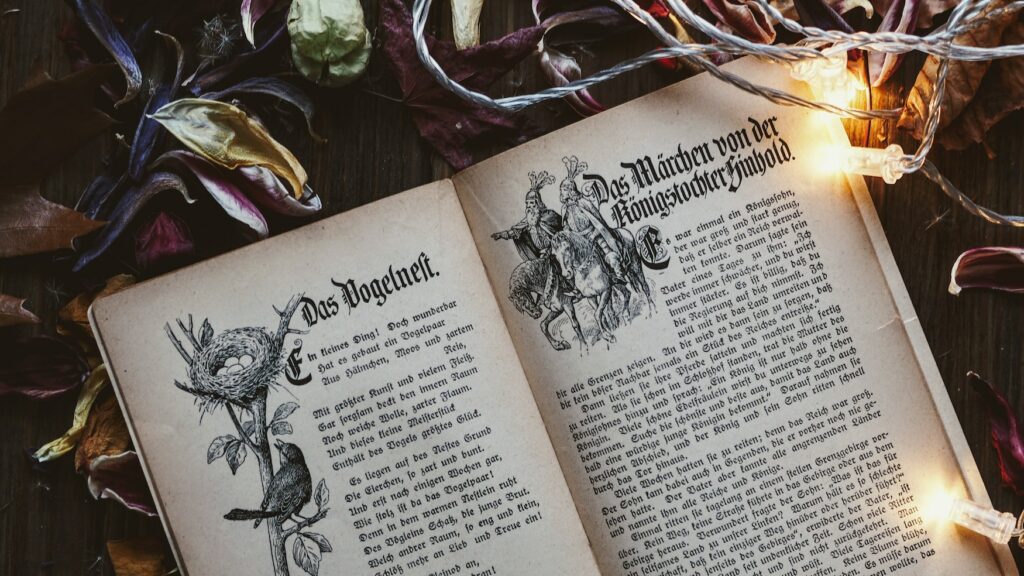
Other works that have become world famous include their fairy tales. In 1812, the first volume of the Grimm’s “Children’s and Household Tales” was published. They wanted to capture the oral tales of proud kings, pretty princesses, benevolent fairies, wicked witches and stepmothers so that they would be preserved for future generations. For them, the fairy tales were the voice of the people, an “original German myth” that needed to be protected. The source of their “folk poetry” is their environment, such as the sisters, Jenny and Annette von Droste-Hülshoff, the innkeeper’s daughter, Dorothea Viehmann and Marie Hasenpflug, one of the most important sources of Grimm’s fairy tales. The families were friends and, like Jacob and Wilhelm, Marie grew up in Hanau. 20 traditions such as “The Seven Ravens”, “Snow White”, “Rumpelstiltskin” and “Sleeping Beauty” come from Marie. The brothers wrote down the oral tales and tweaked their style until they came closest to their idea of folk poetry.
German Fairy Tale Route
If you want to delve even deeper into the world of the Grimm’s fairy tales: The 600 km long “German Fairy Tale Route” begins in Hanau. The well-known German holiday route leads to Bremen in northern Germany, the city of the Bremen Town Musicians. On the way there are around 60 fabulous places where the fairy tales of the Brothers Grimm have left their mark – along dreamlike natural landscapes such as the Weserbergland or the Spessart, to fairytale castles and idyllic German towns. And so, the fairy tales always come alive, just as the brothers wished.



